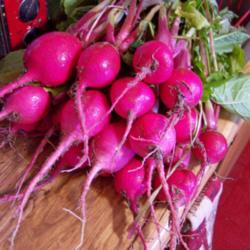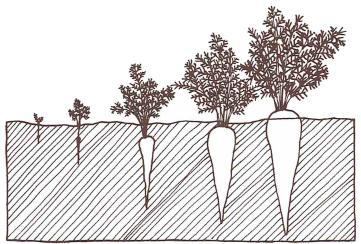
Root crops are cool-season vegetables. Their tiny seeds germinate best in damp soil that's between 50° and 60° F. Early spring and fall are the best times to plant.
GerminationGermination is the sprouting action of seeds, and some root crops germinate more quickly than others. Radishes sprout in just 2 to 3 days; turnips and rutabagas in 5 to 10. The rest are slower, taking from 7 to 20 days to germinate. When they do, tiny seedlings push their way up through the shallow soil covering.
While the seedling develops into the greens above the ground, a large, edible taproot forms and grows downward. It's also the major storage organ of the plant, although it does form smaller, branching side roots to help it gather food, oxygen and water. Some root crops have more of these hairlike roots than others, but you can scrub or wash them off before eating the vegetable.

As the root grows, it expands down, out and up; often showing its shoulders above ground. The sun discolors the exposed root, turning carrots green and turnips purple. Green shoulders on carrots are hard and bitter, so pull the roots before they're big enough to show above ground or cover them with mulch or soil. The colorful top on turnips or rutabagas taste fine.
A cross section of the roots shows that these plants are formed in three layers: a hard core, the edible fleshy part and the skin. The best-tasting roots have the least amount of that tough center, and quick, steady growth helps here.
All root crops need food, water and air. They also develop best if they meet no soil clumps or rocks to check their growth. Give them good growing conditions, and you'll enjoy straight, thick, good-tasting produce. Poor or improper soil preparation is usually to blame for crooked or forked roots. If you've ever bitten into a woody, fibrous carrot, you'll understand why good growing conditions are so important.
When root crops grow wild, some are biennials, forming the root in one season and producing a flowering seed stalk the next. In the garden, we interrupt this natural process by harvesting the roots before they start the reproduction process. Once the roots send up a flower-bearing stem, they're beyond the eating stage.
Differing Growth RatesRoot crops all vary in their growth rates, as do the individual varieties. Short, stocky carrots or beets mature fairly quickly, whereas long, tapered vegetables take longer to fully develop. You can eat the roots as soon as they're finger or marble size, so you have a lot of flexibility when it comes time to harvest.
Root crops could be called the "polar bears" of the garden because both the seeds and the plants are well adapted to sudden drops in temperature. Even hard frosts won't hurt them. In fact, parsnips and salsify need about a week of cool nights to sweeten them. This is because the carbohydrates in the roots change to sugars when the soil temperature is between 34° and 38° F.
Don't Transplant Root CropsEven though you can transplant all vegetables with some success if you're very careful and you know what you're doing, there's really no need to transplant root crops to the home garden. If you want earlier carrots or turnips, get out in the garden earlier and plant the seeds.
Generally it's hard to keep the sensitive roots of any root crop from being upset during transplanting, and this interrupts their growth too much for them to recover completely. Chances are you'll end up with stunted or misshapen roots. And it's really not worth the time or effort when they grow so well started right in the garden.
 Victory Seed Company has all the seeds you want for your best garden in 2024.
Victory Seed Company has all the seeds you want for your best garden in 2024.
For 25 years, the family-owned Victory Seed Company has provided the highest quality vegetable, herb and flower seeds to families across the country. We are passionate about providing you the best seeds available that give excellent germination, robust plants, and the harvest you want. With a catalog of over a thousand varieties, we have everything, and our prices are the kinds that we'd want to pay. We have hundreds of yesterday's heirloom vegetables, as well as today's award winning hybrid selections. Get to know us by visiting our website and browsing through our online vegetable seed catalog.
| 1. History of Root Crops |
| 2. All About Horseradish |
| 3. Beet Varieties |
| 4. Carrot Varieties |
| 5. Radish Varieties |
| 6. Turnip and Rutabaga Varieties |
| 7. Celeriac - Lazy Man's Celery |
| 8. Parsnip Varieties |
| 9. All About Salsify |
| 10. Selecting Root Crop Seeds |
| 11. Planning Your Root Crop Garden |
| 12. How Root Crops Grow ← you're on this article right now |
| 13. Carrot Essentials |
| 14. Parsnip Essentials |
| 15. Radish Essentials |
| 16. Turnip Essentials |
| 1. History of Root Crops |
| 2. All About Horseradish |
| 3. Beet Varieties |
| 4. Carrot Varieties |
| 5. Radish Varieties |
| 6. Turnip and Rutabaga Varieties |
| 7. Celeriac - Lazy Man's Celery |
| 8. Parsnip Varieties |
| 9. All About Salsify |
| 10. Selecting Root Crop Seeds |
| 11. Planning Your Root Crop Garden |
| 12. How Root Crops Grow ← you're on this article right now |
| 13. Carrot Essentials |
| 14. Parsnip Essentials |
| 15. Radish Essentials |
| 16. Turnip Essentials |